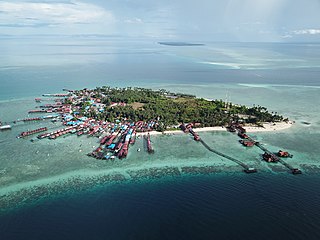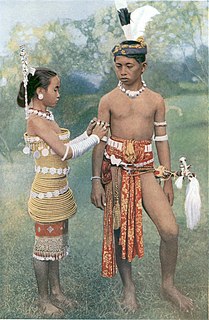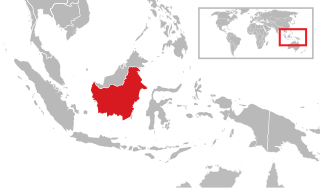
Kalimantan is the Indonesian portion of the island of Borneo. It comprises 73% of the island's area. The non-Indonesian parts of Borneo are Brunei and East Malaysia. In Indonesia, "Kalimantan" refers to the whole island of Borneo. In 2019, the Indonesian President Joko Widodo proposed that Indonesia's capital be moved to Kalimantan.
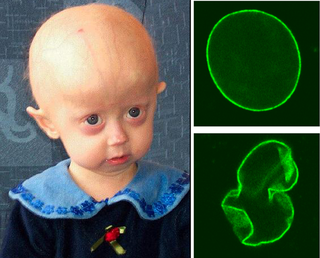
Progeria is an extremely rare autosomal dominant genetic disorder in which symptoms resembling aspects of aging are manifested at a very early age. Progeria is one of several progeroid syndromes. Those born with progeria typically live to their mid-teens to early twenties. It is a genetic condition that occurs as a new mutation, and is rarely inherited, as carriers usually do not live to reproduce children. Although the term progeria applies strictly speaking to all diseases characterized by premature aging symptoms, and is often used as such, it is often applied specifically in reference to Hutchinson–Gilford progeria syndrome (HGPS).

South Sulawesi is a province in the southern peninsula of Sulawesi. The Selayar Islands archipelago to the south of Sulawesi is also part of the province. The capital is Makassar. The province is bordered by Central Sulawesi and West Sulawesi to the north, the Gulf of Bone and Southeast Sulawesi to the east, Makassar Strait to the west, and Flores Sea to the south.

West Kalimantan is a province of Indonesia. It is one of five Indonesian provinces in Kalimantan, the Indonesian part of the island of Borneo. Its capital city is Pontianak. The province has an area of 147,307 km² with a recorded 2010 census population of 4,395,983 . Ethnic groups include the Dayak, Malay, Chinese, Javanese, Bugis, and Madurese. The latest official estimate is 4,546,439. The borders of West Kalimantan roughly trace the mountain ranges surrounding the watershed of the Kapuas River, which drains most of the province. The province shares land borders with Central Kalimantan to the southeast, East Kalimantan to the east, and the Malaysian territory of Sarawak to the north.

South Kalimantan is a province of Indonesia. It is located in Kalimantan, the Indonesian territory of Borneo. The provincial capital is Banjarmasin. The population of South Kalimantan was recorded at just over 3.625 million people at the 2010 Census; the latest official estimate is 4,119,794. One of five Indonesian provinces in Kalimantan, it is bordered by the Makassar Strait in the east, Central Kalimantan in the west and north, the Java Sea in the south, and East Kalimantan in the north. The province also includes the island of Laut, located off the eastern coast of Kalimantan. The province is divided into 11 regencies and 2 cities. South Kalimantan is the traditional homeland of the Banjar people, although there are some part of East Kalimantan and Central Kalimantan that is also included in this criteria. Nevertheless, South Kalimantan, especially the capital city Banjarmasin has always be the cultural capital of Banjarese culture. Many Banjarese has migrated to other parts of Indonesia, as well as neighbouring countries such as Singapore and Malaysia. In addition, other ethnic groups also inhabit the province, such as several group of the Dayaks, who mostly live in the interior part of the province, as well as the Javanese, who mostly migrated from Java due to the Transmigration program which dated from the Dutch colonial era.

Central Kalimantan, is a province of Indonesia. It is one of five provinces in Kalimantan, the Indonesian part of Borneo. Its provincial capital is Palangkaraya and in 2010 its population was over 2.2 million, while the latest official estimate is 2,368,654.

Bidayuh is the collective name for several indigenous groups found in southern Sarawak, Malaysia and northern West Kalimantan, Indonesia, on the island of Borneo, that are broadly similar in language and culture. The name Bidayuh means 'inhabitants of land'. Originally from the western part of Borneo, the collective name Land Dayak was first used during the period of Rajah James Brooke, the White Rajah of Sarawak. At times they were also lesser referred to as Klemantan people. They constitute one of the main indigenous groups in Sarawak and West Kalimantan and live in towns and villages around Kuching and Samarahan in the Malaysian state of Sarawak, while in the Indonesian province of West Kalimantan they are mainly concentrated in the northern Sanggau Regency. In Sarawak, most of Bidayuh population are found within 40 km of the geographical area known as Greater Kuching, within the Kuching and Samarahan division. They are the second largest Dayak ethnic group in Sarawak after the Iban and one of the major Dayak tribes in West Kalimantan.

The Madurese are an ethnic group originally from the island of Madura now found in many parts of Indonesia, where they are the third-largest ethnic group by population. Common to most Madurese throughout the archipelago is the Islamic religion and the use of the Madurese language.

Being an indigenous tribe in Borneo, the Kayan people are similar to their neighbours, the Kenyah tribe, with which they are grouped together with the Bahau people under the Apo Kayan people group.

Pontianak is the capital of the Indonesian province of West Kalimantan, founded by Syarif Abdurrahman Alkadrie as a capital of Sultanate of Kadriyah on 23 October 1771 / 14 Rajab 1185 AH. Syarif Abdurrahman Alkadrie developed Pontianak as a trading port on the island of Borneo, occupying an area of 107.82 km² in the delta of the Kapuas River. It is located on the equator, hence it is widely known as Kota Khatulistiwa. The city center is less than 3 kilometres (2 mi) south of the equator. Pontianak is the 26th largest city in Indonesia in terms of population, as well as the fifth largest city on the island of Borneo (Kalimantan) in terms of population after Samarinda, Banjarmasin, Kuching and Balikpapan.

Samarinda is the capital of the Indonesian province of East Kalimantan on the island of Borneo. The city lies on the banks of the Mahakam River. It is the most populous city on the entire Borneo island, with an estimated population of 842,691, up from 726,223 at the 2010 Census. Although it is the capital of East Kalimantan, some government institutions such as the Police, Indonesian Army District VI Of Tanjung Pura, and Pelabuhan Indonesia are also located in the city. Samarinda is known for its traditional food amplang, as well as the cloth sarung samarinda. The city also has a bridge connecting its river banks, Mahakam Bridge. The city center is on one side and the other side is named Samarinda Seberang.

Punan Ba or Punan is an ethnic group found in Sarawak, Malaysia and in Kalimantan, Indonesia. The Punan Bah people are distinct and unrelated to the semi-nomadic Penan people. Their name stems from two rivers along the banks of which they have been living since time immemorial. They do have other names: Mikuang Bungulan or Mikuang and Aveang Buan. But those terms are only used ritually these days.

The Murut are an indigenous ethnic group, comprising 29 sub-ethnic groups inhabiting northern inland regions of Borneo.
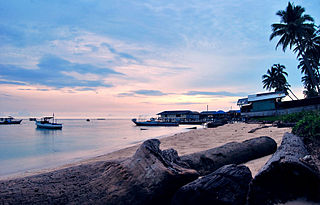
The Derawan Islands are in the province of East Kalimantan in Indonesia. They consist of 31 islands, most well known among these are the islands of Derawan, Maratua, Sangalaki and Kakaban. There are also numerous submerged reefs and islets. They are located in the Sulawesi Sea, on the coastal shelf of East Kalimantan. The islands are part of the Berau Regency.
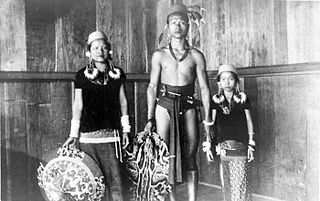
The Kenyah people are an indigenous, Austronesian-speaking people of Borneo, living in the remote Baram, Data Kakus, Data Surau, Senap River, Long Dungan, Long Busang, Long Beyak, Bintulu, Miri, Asap River resettlement for Bakun Dam, Long Bulan, Long Jawe and Belaga regions in Sarawak, Malaysia and the remote Apau Kayan, Bahau (Bau), Benua Lama, Benua Baru and Mahakam regions in East Kalimantan, Indonesia.
This article is about the architecture features of Banjar people of South Kalimantan, Indonesia. There are several types of traditional houses of the Banjarese:
- Bubungan Tinggi
- Gajah Baliku
- Gajah Manyusu
- Balai Laki
- Balai Bini
- Palimbangan
- Palimasan
- Anjung Surung
- Tadah Alas
- Rumah Lanting
- Joglo Gudang
- Bangun Gudang

The Tidung, Tidong are a native group originating from northeastern part of Borneo and surrounding small islands. They live on both sides of the border of Malaysia and Indonesia.
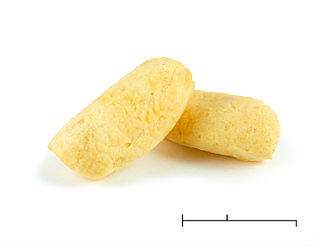
Amplang, also known as kerupuk kuku macan, is a traditional savoury fish cracker snack commonly found in Indonesia and Malaysia. Amplang crackers are commonly made of ikan tenggiri (wahoo) or any type of Spanish mackerel, mixed with starch and other materials, and then fried.

Samarinda Islamic Center Mosque, also known as Baitul Muttaqien Mosque, is a mosque located in the subdistrict of Teluk Lerong Ulu, Samarinda, East Kalimantan, Indonesia, which is one of the largest mosques in Southeast Asia. It situates at the foreground of Mahakam River, and it has seven minarets and a huge dome.
